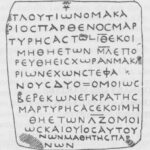| Artefact ID | 1259 |
| TM ID | TM 99084 |
| Findspot (DEChriM ID) | - () | Class | Textual |
| Material | Stone |
| Writing medium | Inscription |
| Text content | Subliterary |
| Language | Greek |
| Description | SB IV 7315; SEG XLIX 2333: Commemorative stela for three martyrs. Limestone slab measuring h. 25,7 cm x w. 22 cm. According to ed. pr., the writing of the text, inscribed in the stone and then painted in red, shows the characteristic features of Constantinian time. The text reads: "Ploutiôn, the blessed virgin (parthenos), having suffered martyrium in the year 19, fell asleep at the age of 41; he went to the land of the blessed having received two crowns. Similarly, Berekôn [=Verecundus] the chaste (egkrates), having suffered martyrium, fell asleep at the age of 37. Likewise his son Konon, disciple of the virgins (mathetes parthenôn)". Initial crux ansata. The mention of "year 19" refers to the era of Diocletian (the 19th year = 302/303 A.D., the first year of Diocletian’s persecution of the Christians in Egypt). According to Łajtar and Wipszycka 1999, this epitaph was meant to commemorate real martyrs but was placed on their tomb later – rather than during the time of persecution (see below, "Dating criteria") – especially as the specific date of their death is not mentioned and was probably forgotten by that time. Later martyrological literature suggests that the two wreaths are a double reward, for martyrdom and for chastity. See also SB I 5719. |
| Selection criteria | Christian terms/formulas/concepts, Christian symbols/gestures/isopsephy |
| Date from | 350 |
| Date to | 399 |
| Dating criteria | The inscription refers to the year 19 of the era of Diocletian (= 302/303) which led ed. pr. to assume that it was the earliest Christian inscription of Egypt. But, according to Łajtar and Wipszycka 1999: 69, the inscription itself was necessarily erected later since the era of Diocletian was not used by Christians before the second half of the 4th c. |
| Absolute/relative date | Relative date |
| Archaeological context | Probably bought in Egypt in 1898 by W. Bock (Łajtar and Wipszycka 1999: 67 referring to De Ricci 1913: 153). |
| Accession number | St Petersburg, Hermitage Museum number unknown |


 Json data
Json data




